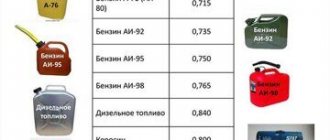Diesel fuel is the most popular petroleum product, which is used as fuel for diesel engines. It is obtained during the distillation of crude oil. The quality composition of diesel fuel is strictly controlled and must meet strict standards.
The density of diesel fuel is the main characteristic that determines the quality of diesel fuel. Fuel density parameters show the ability of the fuel to support the operation of mechanisms under any fluctuations in ambient temperature. The density of diesel fuel (specific gravity) is the amount of its mass in kilograms that fits in one cubic meter. That is, the ratio of the weight of the fuel to its volume. The unit of measurement is kg/m3 or g/cm3. The density of diesel fuel is also affected by the presence of various additives and foreign heavy fractions in it. The presence of the latter negatively affects the quality of the fuel.
The density indicator is not a constant value, since it directly depends on temperature indicators. The higher the temperature, the lower the density of diesel fuel. This indicator is constantly monitored using an aerometer. The optimal temperature for diesel fuel is 18-20°C. When calculating density, a correction factor is used, which is 0.0007 g/cm3 per 1°C
Relationship between fuel density and diesel efficiency
The fuel density and efficiency of a diesel engine directly depend on the air temperature.
Since the combustion process of diesel fuel, which has a high specific gravity, releases a huge amount of energy, significantly exceeding the amount of energy obtained from the combustion of less dense fuel, the use of summer diesel fuel is more economical.
Using this type of fuel in winter will not increase its profitability. This is due to the fact that summer fuel, in addition to kerosene-gas oil hydrocarbons, in which the entire fuel energy reserve is concentrated, contains dissolved paraffin elements. These components have the ability to harden even with a slight decrease in the temperature of diesel fuel. At the same time, diesel fuel becomes viscous, and the throughput of the filters decreases.
To increase the efficiency of internal combustion engines, various additives are added to diesel fuel used in the cold season, which inhibit the hardening of paraffins and increase the density of the fuel. Although such additives lower the thickening temperature of diesel fuel, they affect its density to a small extent. It would seem that if an appropriate additive is added to summer fuel, it can be used as winter fuel, but this is not true. Since the component introduced into the diesel engine only lowers the thickening temperature of the paraffin components of the fuel.
At the same time, the fuel itself will not lose its density, and with a decrease in temperature it will continue to thicken, which will lead to disruptions in engine operation. Another misconception is that when adding an additive to frozen diesel fuel, it is possible to reduce its density. Accordingly, fuel density is an important indicator in the cold season. In hot weather, such characteristics as the percentage of sulfur and cetane number are more relevant.
Naturally, due to changes in the density of diesel fuel, the economic efficiency of fuel in winter is significantly reduced. This is also facilitated by factors such as ice and snow congestion on the roads, which complicate the driving process and increase fuel consumption.
State standards applicable to gasoline
Until the end of the nineties, the production of petroleum products in Russia, in particular the production of gasoline, was regulated by GOST 2084 and TU 38.001165. These standards regulated the production of gasoline grades from A 76 to AI 96 based on their octane number. At that time, the global fuel industry was rapidly developing, cars had powerful engines, and issues of ecology and environmental protection were just beginning to be raised by individual countries. Accordingly, little attention was paid to environmental fuel standards.
Later, outdated GOSTs, along with technological progress, were replaced by newer quality standards that meet modern environmental requirements. Thus, in 1999, GOST R 51105-97 was introduced, regulating the compliance of gasoline with the requirements of the EURO 2 standard. However, in Europe at this time the issue of environmental protection became increasingly relevant. Already in 2000, a more modern environmental quality standard, EURO 3, was introduced in Europe, significantly reducing the permissible levels of metal compounds, including heavy metals, in gasoline.
Following European environmental standards, in Russia, on July 1, 2002, a new standard GOST R 51866-2002 (EH 228-2004) was adopted. This standard has already applied to the brands of high-quality high-octane gasoline Premium Euro 95 and Super Euro 98, as well as their types.
A few years later in the European Union, the EURO 3 standard was replaced by the new environmental standard EURO 4. Following this, in Russia, on January 1, 2015, GOST 32513-2013 and TU 0251-001-12150839-2015 were adopted. Both of these documents set quality standards for modern gasoline, with an octane number of at least 80 according to the research method.
After the introduction of the new EURO 5 standard, environmental requirements for fuel quality have become significantly stricter. In Russia, the EURO 5 standard was adopted on January 1, 2016. In fact, currently all imported cars imported into Russia and the fuel produced comply with this standard. Today, technical regulations regulate more than twenty characteristics of gasoline, including the proportion of benzene, which increases the octane number of gasoline, but causes significant harm to the environment. In addition, in accordance with EURO 5 requirements, gasoline is not allowed to contain metal-containing components that form toxic compounds and seriously affect the environment.
This is interesting: How to correctly calculate the fuel consumption rate
Formulas for calculating the density, weight and volume of diesel fuel
The density of diesel fuel, its weight and volume is calculated using certain formulas in accordance with GOSTs.
Based on the fact that the density indicator directly depends on temperature, for the accuracy of calculations it is worth taking into account the correction factor and the ambient temperature indicator.
According to the formula, the density of diesel fuel is calculated as the ratio of the mass of the fuel to its volume.
- V = m/p, where
- V—volume;
- m—mass;
- p – density
when calculating the density of diesel fuel is taken:
- for summer fuel 860kg/m3;
- for winter fuel 840 kg/m3.
Accordingly, 1 kg of summer fuel is 1.19 liters, and 1 kg of winter fuel is 1.16 liters.
1 liter contains 0.860 and 0.840 kg of diesel fuel
The density of the petroleum product must strictly comply with regulations. The density recorded at 20°C is taken as a standard. To simplify calculations, special tables have been compiled in which, knowing the weight and volume of the product, as well as the temperature, you can easily find the required indicator.
The weight of diesel fuel is calculated by simply multiplying the density of the petroleum product by its volume. To calculate the mass of diesel fuel in tons, use the formula:
M(mass)=V (volume in liters)*p(density kg/m3)
To calculate the mass of summer fuel having a density of 0.860 kg/m3 with a volume of 1000 liters, we have the following value:
M=1000*0.860
This formula also applies to other types of fuel with different density parameters. Quantitative indicators so far are easily converted from tons to kilograms and vice versa. The calculation of volume, accordingly, is carried out using the inverse formula - the mass of the product is divided by its density. This calculation is very important when drawing up accounting documents for fuel, in which it becomes necessary to convert the weight of fuel into volume for the correct selection of containers.
Calculation of diesel fuel from tons to liters can be done using the formula:
V = (M / 0.850) x 1000, l.
where M is fuel in tons
The average value of 850 kg/m3 is most often used as an indicator of the density of diesel fuel.
How to convert liters to tons - formula and density table | Holiday
Converting liters to tons - formula and density table.
In the process of calculating various substances, it may be necessary to convert one unit of measurement to another. Most often, liters are converted to tons when taking into account different types of fuel.
Converting a liter to a ton is not easy. A liter is a measure of volume equal to 1 cubic decimeter, and a ton is a measure of mass equal to 1000 kg, so you will have to use a mathematical formula to convert between units.
Formula for converting liters to tons
To convert a measure of volume (liter) to a measure of mass (ton), you need to divide the number of liters by 1000, and then multiply the resulting figure by the density of the substance, measured in grams per cubic centimeter using the formula Mt=Vl/1000*P, where:
Mt – mass of substance in tons; Vl – volume of substance in liters; P is the density of the substance in grams per cubic centimeter.
For example, to calculate the mass of 100 liters of water, you need:
100 divided by 1000. The result is 0.1; 0.1 must be multiplied by 1 (the density of water is 1 g/cm3). It turns out that 100 liters of water equals 0.1 ton or 100 kg.
If the density of a substance is measured in the SI system (in kilograms per cubic meter), then to convert the volume of liquid (in liters) into mass (in tons), you need to divide the number of liters by 1,000,000 and multiply by the density of the substance, measured in kilograms per cubic meter according to formula Mt=Vl/1000000*P, where:
Mt – mass of substance in tons; Vl – volume of substance in liters; P is the density of the substance in kilograms per cubic meter.
Density of main fuels
Automotive fuel is most often supplied in tanks with a fixed volume and is measured in tons, so the formula for converting a liter to a ton is often used in fuel accounting. In order not to measure the density of liquid or gaseous fuels, it is useful to use the average density values for these substances in calculations:
The density of AI-80 gasoline is 0.715 g/cm3; The density of AI-92 gasoline is 0.735 g/cm3; The density of AI-95 gasoline is 0.750 g/cm3; The density of AI-98 gasoline is 0.7765 g/cm3;
Table of densities of some substances
| ρ, 103 kg/m3 | |||
| Water | 0,99823 | Vaseline oil | 0,8 |
| Water is heavy (H 2/2 O) | 1,1086 | Machine oil | 0,9 |
| Glycerol | 1,26 | Medium fat milk | 1,03 |
| Oil | 0,76–0.85 | Sea water | 1,01–1,03 |
How to check the density yourself
To ensure that the quality of the purchased fuel is not in doubt, vehicle owners should purchase it only from trusted suppliers. If you have doubts about the quality of the product, you can check the fuel density yourself.
The need for such a check arises only in the winter season. It should be carried out at a temperature of -8 – 10°C, and if the fuel is positioned as arctic, then lower.
To carry out the test, place a small amount of diesel fuel on a metal surface, and then monitor the cloudiness and spread of the product. If the fluidity of the fuel is normal, we can talk about its quality; if the liquid becomes cloudy and begins to solidify, then it is better to refuse to use it. Diesel fuel for use in the cold season should not freeze to -45°C.
Another way to check is to place a container with fuel where the air temperature is 20 degrees. When the ambient and diesel temperatures are equal, the density is measured with an aerometer and its readings are compared with GOST data.
The fastest inspection option is to visually evaluate the refueling nozzle. If the fuel at its end remains liquid, then this indicates its quality.
You can more accurately check the density of diesel fuel as follows. Diesel fuel is poured into a small container and then placed in conditions where the air temperature is around + 17 to +20 degrees for such a time that the fuel warms up to a similar temperature. Next, the density of the diesel is measured using a hydrometer. The obtained data must be compared with the standards that, according to GOST, purchased diesel fuel must meet.
Densities, specific gravities of gasoline, diesel fuel and other petroleum products | Deif
The comparative densities of some petroleum products are given in the table.
| Type of fuel | Density, g/cm³ |
| A92 grade gasoline | 0,76 |
| A95 grade gasoline | 0,75 |
| A98 grade gasoline | 0,78 |
| Aviation kerosene | 0,81 |
| Liquefied gas | 0,53 |
| Biodiesel fuel | 0,87 |
The reduced density of motor gasoline is determined by the presence of light fractions, which begin to boil away at 50°C. In this case, the liquid remains fluid when cooled to -55°C, crystallization begins at -60°C. The density of motor fuel for spark-ignition engines is specified by the GOST 32513-2013 standard; the parameter is measured at an ambient temperature of 15°C. Density is measured using a theoretical calculation method or using a hydrometer, which is immersed in a container of fuel.
The hydrometers used are manufactured in accordance with the GOST 18481-81 standard; the design is designed for operation in winter and summer. Manufacturers produce instruments designed for testing gasoline or heavy fuels (including fuel oil). The equipment has an error, for example, the ANT-1 device determines parameters with an accuracy of 500 g/m³. The hydrometer is lowered into the tank, the parameter is determined by the depth of immersion of the product in the liquid. The readings are read at the bottom mark of the graduated scale.
What determines the density of diesel fuel?
The density of diesel fuel is not constant. It changes under the influence of temperature parameters. This indicator is based on the ratio of fuel mass to its volume. When making calculations, the brand of diesel fuel and the correction factor are taken into account. There are several main types of diesel fuel - summer and winter types. Winter fuel has a lower density, which avoids thickening at low temperatures.
The correct selection of fuel additives can to some extent affect the density of the liquid.
Density of diesel fuel and temperature are directly related to each other.
To obtain standard indicators, the density of the fuel is produced at a temperature of 20°C and normal atmospheric pressure. And to calculate density at different temperatures, correction factors or special density tables are used.
There is a certain standard according to which the fuel density is:
- in winter – 860 kg/m3;
- in summer - 840 kg/m3;
- in Arctic conditions – 830 kg/m3.
Separation of diesel fuel according to GOST
According to GOST 305-82, diesel fuel is divided depending on the season of use into the following types:
- Summer - remains liquid down to only -5 ◦ C. It is recommended to use it at air temperatures above zero Celsius.
- Winter - should not thicken to -35 ◦ C. Used in frosts below -20 ◦ C.
- Arctic – hardens no higher than -50 ◦ C. Recommended for use in frosts below -45 ◦ C.
The weight of one cubic meter of summer diesel fuel should be no more than 860 kg. The weight of a cubic meter of winter diesel fuel should be no more than 840 kg. The weight of a cube of Arctic diesel fuel should not exceed 830 kg. GOST prescribes measuring the weight of diesel fuel at 20 degrees Celsius.
Standards for calculating the density of diesel fuel
For the unity of calculating the density of diesel fuel, unified regulatory documentation has been developed, which spells out the main components for correct calculations:
- the reference temperature is 20°C;
- a change in temperature for each degree requires an adjustment of 0.0007 g/cm3;
- when the diesel fuel temperature increases from the reference values, a correction factor should be subtracted by multiplying it by the difference in degrees Celsius;
- when the temperature decreases, a coefficient is added to the reference indicators, which is multiplied by the temperature difference in degrees Celsius.
What affects the density of gasoline
✅The first point that affects the density of gasoline is the change in fuel composition after release from production. This fact is present when the product is improperly stored or deliberately diluted to obtain excess profits.
✅The second point that affects the density of gasoline is its original composition. All brands of gasoline have their own content of hydrocarbons, sulfur, oxygen, lead and other components. And their combination gives the final density of the resulting brand of gasoline.
✅The third point on which the density of gasoline depends is the change in ambient temperature. In this case there is no increase or decrease in fuel weight. And since the shipment is made in kilograms, there is no deception, even if the displacement is less than expected. As the temperature increases, the liquid will expand and the volume will increase. The density of gasoline will also change. However, the weight will remain the same.
Changes in ambient temperature and density of petroleum products
The third factor affecting the density of gasoline is the most common. And it is precisely because of this that misunderstandings arise between drivers and gas station employees. As the air temperature decreases, the level of gasoline in the tank drops. There is a suspicion that they were deceived at the gas station. However, this is not the case, because filling occurs in a different measurement unit: in kilograms, not liters. And if you drain the remainder from the tank and weigh it, it will correspond to the norm.
Of course, it is impossible to drain an entire industrial tank into another container just to measure the density. This is why a simple formula is used. It also helps to calculate the density of any gasoline: p=m/V, where p is the density, V is the volume of fuel in the tank according to the mark, and m is the mass.
Using the same variables, you can find out mass or volume. That is, all parameters involved in one formula. The complexity is at the primary school level, but the benefits are enormous.
There is only one correction to this formula. To correctly calculate the weight, it is necessary to take into account the coefficient of temperature change. The fact is that the accepted standards specified in GOST were calculated under the condition of a stable ambient temperature. For gasoline this is +15 °C. And for the calculation to be correct at a different temperature, it is necessary to adjust the density indicator by 0.0007 g/m3 with a change of 1 °C. Or use the table for adjusting fuel density depending on temperature changes.
Changes in fuel composition and density of petroleum products
The types of components in the fuel and their quantities directly affect the density. And when intentional dilution of gasoline occurs, it is no longer possible to rely on the table of density of petroleum products.
If we do not take into account the intentional spoilage of fuel, then the difference in composition implies a different density of AI-95 gasoline with AI-92 and any other brand. That is, literally each type of petroleum product has its own value, as well as its own set of components in the composition.
The density of all types of light fuel was previously established by GOST 305-82. The regulations stated that measurements must be carried out at a temperature of +20 °C. Studies carried out already in the 2000s made amendments to the previously established temperature threshold. This is how the separation of regulations for diesel fuel and gasoline appeared.
Today, GOST R 32513-2013 is in force, which states that measurements of the density of gasoline of all brands should be carried out only at a temperature of +15 °C. The same GOST regulates the following indicators:
| Gasoline brand | 80 | 92 | 95 | 98 |
| Density indicators, kg/m3 | 700-750 | 760 | 750 | 780 |
To understand why there is a density difference between brands of gasoline, it is necessary to study how the fuel is produced and its characteristics.
Density of diesel fuel in summer and winter
The fuel used in summer and winter differs in its basic characteristics.
For winter, fuel that has the following indicators is suitable:
- low density;
- low viscosity;
- does not freeze at a temperature of -45O.
Low viscosity density allows the fuel not to turn into a gel and circulate freely inside the internal combustion engine. In cold weather, the use of high-density fuel is strictly prohibited in order to avoid problems with the filter system.
Summer fuel is characterized by:
- high density (not less than 0.86 kg/l);
- difficult to ignite (withstands temperature increases up to +45°C).
When winter fuel is used in the summer, engine power decreases and smoke levels increase.
The best time for summer fuel is April - September, if the temperature does not drop below -4°C. Otherwise, the diesel fuel will become cloudy, and when the temperature drops another few degrees, it can lead to problems with engine operation.
Examples of diesel fuel density at different temperatures
When calculating fuel density, the following data must be taken into account:
- fuel density indicators at reference values specified in the petroleum product passport;
- actual liquid temperature measured in the transport container;
- apply a correction factor of 0.0007 when calculating the temperature difference;
- make adjustments to the calculation. At elevated temperatures, subtract the resulting value from the density indicated in the passport, and at low temperatures, add it.
Calculation of specific gravity for 20 ◦c
The theoretical calculation of specific gravity consists of the following steps:
- The purpose of the calculation is to determine the specific gravity at a reference temperature of 20°C. At the initial stage, it is necessary to measure the density with a hydrometer and the temperature of the liquid with a thermometer in the container in which the fuel is stored.
- Determine the temperature difference between the measured parameter and 20°C.
- Calculate weight adjustment taking into account delta and correction factor.
- Add or subtract (depending on the deviation from 20°C) the correction value from the parameter read from the hydrometer. The resulting weight allows you to roughly determine the type of fuel (winter, summer or arctic). The type of fuel determines the ability of diesel fuel to be used in different temperature zones without the risk of excessive increase in viscosity or crystallization in fuel pipes.
Diesel fuel density, consumption, operation
The density of diesel fuel is the main characteristic for determining the climatic use of diesel fuel and its impact on the operation of the internal combustion engine. If the fuel is chosen incorrectly or the quality of the liquid is not high, this will significantly reduce the efficiency of the engine, especially at the time of start-up. Which, in turn, will lead to an increase in fuel consumption to increase engine efficiency. Excessive load on the fuel system can cause increased fuel consumption and even cause engine failure.
What does density say about the quality of diesel fuel?
The density of diesel fuel is determined by the ratio of the fractions that make up the fuel. If the composition of the fuel is dominated by heavy hydrocarbons, this will negatively affect the operation of the engine and reduce the injection of liquid by the injectors into the combustion chamber. Heavy fractions have a high boiling point, which reduces the mixing of fuel microparticles with air. In order for diesel fuel vapors to ignite, a higher temperature will be required, and this will cause problems in the operation of the engine and lead to increased fuel consumption.
A clear example of misunderstandings related to counting
On a warm day with an air temperature of 200C, a fuel truck poured 10 tons of diesel fuel into the underground tank of a gas station. The actual density of the product was 0.84 g/cm3 and the volume was 11950 liters.
After several hours of the fuel being in the indicated container, its temperature dropped to 40C. This led to a change in the density of the fuel: it increased by 0.0112 g/cm3. Therefore, the original volume from 11950 liters decreased to 11750 liters. That is, 200 liters.
Therefore, in practice, fuel shrinkage is calculated using the simplified formula “1 liter x 1 ton x 1 degree”. This will make it possible to roughly calculate how much the volume of fuel will change when its temperature, and therefore density, changes.
Happy New Year and Merry Christmas!
Congratulations from the RusPetrol team.
Changes in the ruble program card service network:
Carrying out technical work at PTK gas stations
Information about temporary suspensions of supply of fuel, related products, etc.
Rosneft gas stations in Moscow and Moscow Region have started selling Euro-6 gasoline.
Moscow Rosneft gas stations have begun the transition to high-octane fuel, the highest environmental class today.
Unique high-octane gasoline will increase mileage and reduce emissions
Based on the results of the tests, Pulsar-100 fuel meets the most stringent international standards and is suitable for use in cars with highly accelerated engines.
Rosneft filling station chain sells winter fuel
Depending on the region, gas stations supply either off-season grades of diesel fuel or winter grades.
© RusPetrol LLC, 2007-2020
Reproduction of site materials is permitted with the consent of the owner
To begin with, the density of diesel fuel, like any other liquid, strongly depends on its temperature. Therefore, to obtain comparable results, the density of diesel fuel is measured at 20 degrees Celsius. Diesel fuel (DF) is liquid hydrocarbons used as fuel for diesel internal combustion engines. Typically, this term refers to fuel obtained from kerosene-gas oil fractions using direct distillation of oil. The density of a fuel is actually its specific gravity. This value is measured in kilograms per cubic meter or grams per centimeter cubed.
The name “diesel oil” comes from the German Solaröl (solar oil) - this is how the heavier fraction formed during the distillation of oil was called for its yellow color back in the mid-19th century.
The Soviet oil refining industry produced fuel "Solar oil GOST 1666-42 and GOST 1666-51". It was intended for use as diesel fuel in medium-speed diesel engines (with a crankshaft rotation speed not exceeding 1000 rpm). It was used, as a rule, for agricultural and other special equipment, and everyone knew it under the name “diesel oil” or “solar oil”. Solar oil is not suitable for refueling modern cars with high-speed internal combustion engines.
Why does diesel fuel consumption increase in winter?
At low temperatures, fuel consumption increases significantly due to the cost of warming up the unit before starting work and increased friction in a cold engine. After the start of movement, diesel fuel consumption does not exceed summer levels, and, possibly, decreases because... torque at low speeds reduces wheel slip on snow surfaces. Thick oil in gearboxes exerts a noticeable load. At low temperatures, the specific gravity of air becomes higher, which contributes to a change in the composition of the working mixture. Cold air also increases the drag coefficient, which increases diesel fuel consumption by several percent every 100 km.
Why does diesel fuel freeze?
Some fractions that make up diesel fuel thicken at low temperatures. The viscosity index directly depends on the ambient temperature and is determined by the density of the liquid, which depends on the number of fractions with a high boiling point. If there is water in the diesel fuel, it will sink to the bottom of the tank. There it will freeze at subzero temperatures. Ice will block the entrance to the intake tube and cut off the fuel supply to the engine. To resume operation of the unit, you will need to warm up the fuel tank and fuel supply system.











